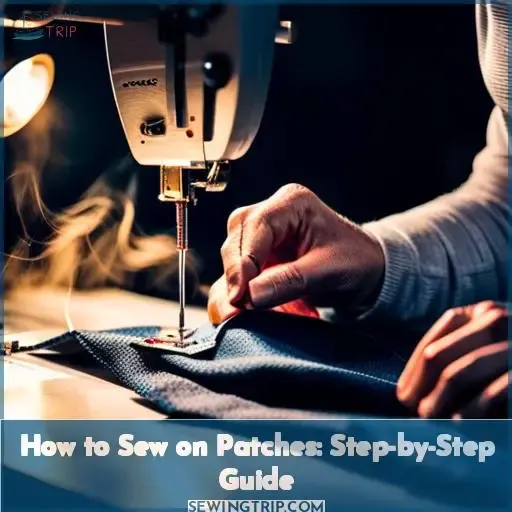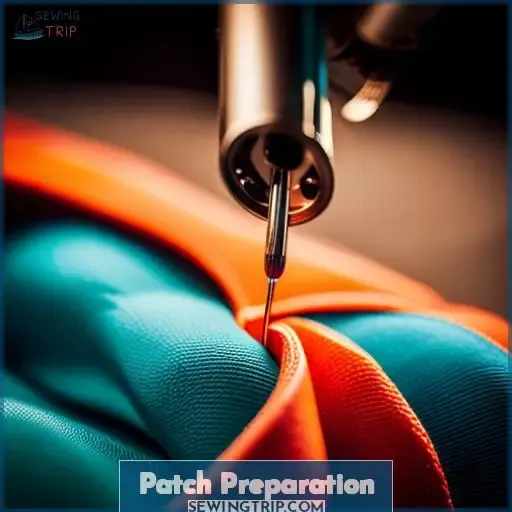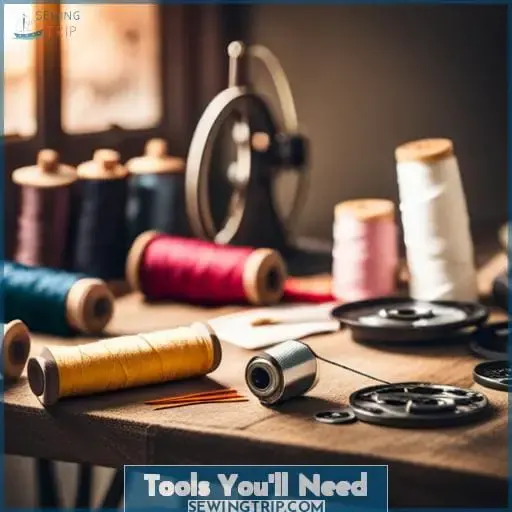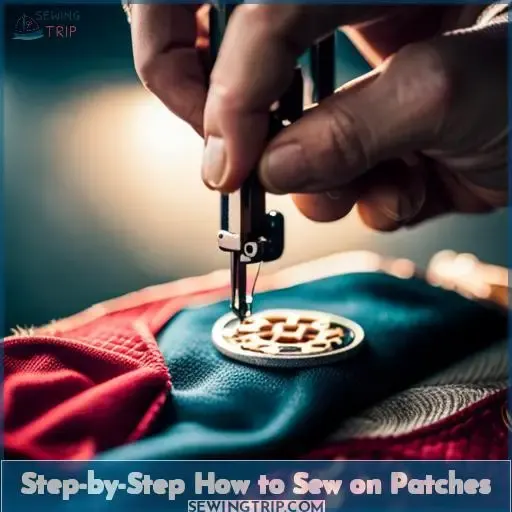This site is supported by our readers. We may earn a commission, at no cost to you, if you purchase through links.
 Imagine your favorite jacket, worn and loved but missing that extra touch. Well, it’s time to unleash your inner sewing superhero and learn how to sew on patches! In this step-by-step guide, we’ll show you the secrets of transforming any garment into a personalized masterpiece.
Imagine your favorite jacket, worn and loved but missing that extra touch. Well, it’s time to unleash your inner sewing superhero and learn how to sew on patches! In this step-by-step guide, we’ll show you the secrets of transforming any garment into a personalized masterpiece.
From preparing the patch to threading the needle and stitching with finesse, you’ll be able to add patches like a pro in no time.
Table Of Contents
Key Takeaways
- Proper patch preparation is essential for a smooth and secure attachment.
- There are various adhesive options available for patch application, including iron-on patches, fabric glue, fusible webbing, and double-sided tape.
- Initiating a backstitch and securely knotting the thread is important during the sewing process.
- When sewing on patches, choosing the right thread color and matching it with the patch and fabric is crucial for a visually pleasing result.
Patch Preparation
Before you begin sewing on your patch, it’s important to properly prepare it.
Start by cleaning up any tears or damaged areas around the patch site, removing white threads and fluff for a neater appearance.
Next, pin or iron down the patch onto your fabric to ensure it stays in place during stitching.
Taking these steps will help create a smooth and secure attachment for your sew-on patch.
Clean Up Tear
To clean up a tear before sewing on a patch, gather the necessary materials.
Here’s what you’ll need for tear cleanup:
- Sewing pins: Use these to secure the fabric around the tear and keep it in place while you work.
- Scissors: Trim any loose threads or excess fabric around the torn area for a neater finish.
- Thread color matching your fabric or patch: This ensures that your repairs blend seamlessly with the rest of your garment.
- Sew-on patch: Once you’ve cleaned up and prepared the tear, align and position your chosen sew-on patch over it for stitching later on.
Pin or Iron Down the Patch
Pin the patch in place or use an iron to adhere it securely to your fabric. Precision pinning ensures accurate patch alignment before sewing.
To help you visualize the process, here’s a table highlighting different adhesive options and their benefits:
| Adhesive Options | Benefits |
|---|
Get creative with your ironing techniques by using decorative patterns like chevron stripes or crisscross designs.
Sewing Process
Now that you have prepared your needle and thread, it’s time to start sewing on your patch.
Begin by initiating a backstitch, pushing the needle up through the fabric and patch with the knot on the wrong side.
Continue stitching using a backstitch pattern, moving 1/4 inch to the right with each stitch until you reach the starting point.
Finish off your backstitch by tightly knotting the thread on the backside of fabric for added security before cutting any loose threads.
Thread Your Needle
Thread your needle by carefully inserting the thread through the eye using a needle threading tool or wetting the end.
Choose a thread color that matches or complements your patch.
Ensure you have selected an appropriate needle and tie a knot at the end of your thread for durability.
Start Your Backstitch
Now it’s time to begin stitching your patch in place with a backstitch.
Thread your needle, tie a knot at the end for durability, and push the needle up through the fabric and patch to start your backstitch.
Continue Stitching
Continue stitching by moving your needle 1/4 inch to the right with each stitch, ensuring that the patch stays securely in place. This technique not only reinforces the attachment but also adds a decorative touch to your personalized designs.
Don’t forget to finish with a backstitch and cut any excess threads for a polished look.
Finish Your Backstitch
To complete your backstitch, securely knot the thread on the backside of the fabric using double or triple knots for added security.
- Experiment with different knotting techniques to find what works best for you.
- Consider using a contrasting thread color to make your stitches stand out.
- Use pins to secure your patch in place while stitching for precise alignment.
- Remember to take breaks and protect yourself with a thimble when necessary.
Cut Your Threads
To finish off your sewing process, it’s time to cut your threads.
Ensure a clean and precise finish by snipping the excess thread close to the knot.
This final step adds an extra touch of professionalism and ensures that your patch is securely attached.
Tools You’ll Need
Now that you know the step-by-step sewing process for attaching patches, let’s talk about the essential tools you’ll need to get started. Having the right tools will make your patch sewing experience smooth and enjoyable.
Firstly, you’ll need a measuring tape to ensure accurate patch placement. This handy tool will help you find the perfect spot on your garment or fabric where your patch should go.
Next up is a piece of clothing or fabric where you want to attach your patch. Choose something sturdy and preferably with enough space for seamless integration.
Of course, don’t forget about the star of this show – the patch itself! Whether it’s a sew-on or iron-on type, make sure it matches well with both its surroundings and any tear cleanup required beforehand.
Speaking of thread selection, pick one that complements or contrasts nicely with either your chosen fabric color or edge of your fabulous new addition!
Last but not least are two key players: sewing needle and thread. These reliable partners in crime work hand-in-needle (pun intended) together to bring life into those patches by securing them firmly onto their designated spots on clothing items using various techniques such as machine vs.
So gather these trusty companions along with some patience & determination because soon enough mastery over this craft awaits!
Step-by-Step How to Sew on Patches
To sew on a patch, start by:
- Pinning or adhering the patch in the desired spot on your fabric.
- Preparing your sewing machine with a matching thread and adjusting any settings as needed.
- Carefully stitching around the edges of the patch using either a straight stitch or zig-zag stitch to securely attach it to your fabric.
Pin or Adhere the Patch in the Right Spot
First, secure the patch in the desired location using sewing pins or adhesive fabric tape.
Pinning precision is crucial to ensure accurate placement before stitching. However, if you prefer a temporary option or don’t want to leave pinholes on your garment, adhesive alternatives like fabric tape can be used instead.
Consider tape vs pins based on your preference and convenience. This step allows you to try on the patch and make adjustments before committing with decorative stitches.
Choose pins that are sturdy yet easy to remove once you’re ready for sewing.
Prepare Your Sewing Machine
Once you have pinned or adhered the patch in the right spot, it’s time to prepare your sewing machine for attaching it securely.
Begin by setting up your machine with the appropriate settings for stitching patches.
Thread your needle, making sure to match the thread color to either the patch or fabric.
Double-check that everything is properly threaded and loaded before starting.
Taking a moment to ensure your machine is ready will make sewing on patches a breeze.
Match the Thread to the Fabric
To match the thread to your fabric, consider the color and weight of both materials.
- Color Harmony:
When selecting your threading material from various options like polyester or cotton threads, aim for cohesion between patch colors and corresponding fabrics used in clothing repairs.
- Thread Selection:
Make sure you have compatible threading material based on factors like tensile strength needed during stitching applications while taking advantage of choices available through online stores specializing in sew-on patches supplies.
- Fabric Compatibility:
Choose threads based not just on their intended use but also according to what kind(s)of textiles comprise garments repaired—considerations include compatibility among fibers present within given textile mixes utilized by specific brands’ customized designs offered via personalization services found at places known primarily because they sell items related somehow directly linked towards individuals seeking ways expressing creativity alongside fashion-forward thinking patterns leading customers closer achieving liberation goals associated gaining mastery skillsets relevant desired outcomes tied into power dynamics involving garment repair processes requiring accuracy, attention to detail, and craftsmanship required for successful completion of tasks hand involved in making clothes look better than before sewn together applying old-fashioned methods seen seamstresses and craftsmen centuries past still hold valuable lessons modern-day tailors and seamstresses alike striving to create the best possible outcomes combining various thread choices and fabrics suited individual customers’ needs.
- Contrast Choices:
For those who desire contrast between their patches and the fabric, selecting a thread color that stands out can be an effective choice.
By following these steps to match the thread to your fabric, you’ll ensure not only a seamless sewing experience but also achieve visually appealing results when attaching custom patches.
Frequently Asked Questions (FAQs)
Can I sew on a patch using a sewing machine?
Absolutely!
Sewing on a patch using a sewing machine isn’t only efficient but also gives you the power to create strong and professional-looking attachments.
What type of thread should I use for sewing on patches?
Choose a thread that suits your patch color and fabric.
Let it weave through the needle, doubling up and knotting the end for strength.
With this powerful combination, you’ll master patch sewing in no time!
How do I remove a sew-on patch if I want to replace it?
To remove a sew-on patch,
- Carefully pluck out the stitches using a seam ripper.
- Be cautious not to damage the fabric.
- Iron the garment afterward to eliminate any marks before attaching your new patch.
Can I sew on patches with a regular needle, or do I need a specific type?
To sew on patches, use a regular needle for most fabrics.
However, consider using a ballpoint or leather needle for thicker materials like denim or leather.
Choose the right tool to ensure successful patch attachment.
What should I do if my patch starts to come loose after sewing?
If your patch starts to come loose after sewing, don’t fret! Simply reinforce it by:
- Stitching over the edges
- Adding a few extra stitches
This will ensure that your patch stays securely in place for long-lasting style and confidence.
Conclusion
To sum it up, sewing on patches is a fun and creative way to personalize your favorite garments. With just a few simple steps, you can transform any item into a unique masterpiece.
By properly preparing the patch, threading your needle, and using the right stitching technique, you’ll be able to sew on patches like a pro.
So grab your sewing supplies, unleash your inner sewing superhero, and start adding that extra touch to your wardrobe!










